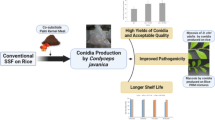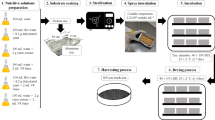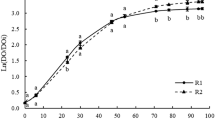Abstract
Laboratory and field studies were conducted to examine the prospect of mycelial application of Hirsutella thompsonii as an alternative to the use of mycelial–conidial formulations of the fungus in the suppression of the coconut mite, Aceria guerreronis. In a series of laboratory experiments, glycerol, yeast extract powder and dehydrated malt extract broth were found to be the best among nine substances investigated as possible adjuvants for use on coconut palms in the field along with H. thompsonii mycelia. H. thompsonii biomass in the presence of adjuvants not only produced more colonies but also yielded more conidia per pellet. In terms of the density of conidia generated on a mycelial mat the treatments varied highly significantly in two methods, with glycerol showing an average of 106% increase over control. Though irradiance with simulated sunlight resulted in reduced conidiogenesis, in general, adjuvant-treated pellets, both exposed and unexposed to simulated sunlight, produced substantial conidiation compared with control, irrespective of the two incubation conditions. Better conidiation was observed under alternating light–dark regime than under total darkness in all the treatments. Glycerol boosted the pathogenicity of H. thompsonii by 16.5% over control. In the field, a newly developed mycelial formulation of H. thompsonii applied after tank-mixing separately with the three selected adjuvants brought down the post-treatment population of the coconut mite by 85.6–97.1%. Application of the fungus in combination with glycerol resulted in a tolerable mean nut damage grade of 2.0 during the pre-harvest stage, compared with an acute score of 4.0 in control palms.

Similar content being viewed by others
References
Burges HD (1998) Formulation of mycoinsecticides. In: Burges HD (ed) Formulation of microbial biopesticides: beneficial microorganisms, nematodes and seed treatments. Kluwer Academic Publishers, Dordrecht, The Netherlands, pp 131–185
Fargues J, Goettel MS, Smits N, Ouedraogo A, Vidal C, Lacey LA, Lomer CJ, Rougier M (1996) Variability and susceptibility to simulated sunlight of conidia among isolates of entomopathogenic Hyphomycetes. Mycopathologia 135:171–181
Fernando LCP, Manoj P, Hapuarachchi DCL, Edgington S (2007) Evaluation of four isolates of Hirsutella thompsonii against coconut mite (Aceria guerreronis) in Sri Lanka. Crop Prot 26:1062–1066
Fuxa JR (1987) Ecological considerations for the use of entomopathogens in IPM. Annu Rev Entomol 32:225–251
Goettel MS, Inglis GD (1997) Fungi: Hyphomycetes. In: Lacey LA (ed) Manual of techniques in insect pathology. Academic Press, London, UK, pp 213–249
Inglis GD, Goettel MS, Johnson DL (1995) Influence of ultraviolet light protectants on the persistence of the entomopathogenic fungus, Beauveria bassiana. Biol Control 5:581–590
Inglis GD, Goettel MS, Butt TM, Stansser H (2001) Use of hyphomycetous fungi for managing insect pests. In: Butt TM, Jackson C, Magan N (eds) Fungi as biocontrol agents: progress, problems and potential. CAB Publishing, CAB International, Wallingford, UK, pp 23–69
Jenkins NE, Heviefo G, Langewald J, Cherry AJ, Lomer CJ (1998) Development of mass production technology for aerial conidia for use as mycopesticides. Biocontrol News Inform 19(1):21N–31N
Kenneth R, Muttath TI, Gerson U (1979) Hirsutella thompsonii, a fungal pathogen of mites. I. Biology of the fungus in vitro. Ann Appl Biol 91:21–28
Kenney DS (1986) DeVine®—The way it was developed—an industrialist’s view. Weed Sci 34(Suppl. 1):15–16
McCoy CW (1981) Pest control by the fungus Hirsutella thompsonii. In: Burges HD (ed) Microbial control of pests and plant diseases 1970–1980. Academic Press, London, UK, pp 499–512
McCoy CW, Couch TL (1982) Microbial control of the citrus rust mite with the mycoacaricide, Mycar®. Fla Entomol 65:116–126
McCoy CW, Selhime AG, Kanavel RF, Hill AJ (1971) Suppression of citrus rust mite populations with application of fragmented mycelia of Hirsutella thompsonii. J Invertebr Pathol 17:270–276
McCoy CW, Hill AJ, Kanavel RF (1975) Large-scale production of the fungal pathogen Hirsutella thompsonii in submerged culture and its formulation for application in the field. Entomophaga 20:229–240
Moore D, Alexander L (1987) Aspects of migration and colonization of the coconut palm by the coconut mite, Eriophyes guerreronis (Keifer) (Acari: Eriophyidae). Bull Entomol Res 77:641–650
Moore D, Bridge PD, Higgins PM, Bateman RP, Prior C (1993) Ultraviolet radiation damage to Metarhizium flavoviride conidia and the protection given by vegetable and mineral oils and chemical sunscreens. Ann Appl Biol 122:605–616
Navia D, de Moraes GJ, Roderick G, Navajas M (2005) The invasive coconut mite Aceria guerreronis (Acari: Eriophyidae): origin and invasion sources inferred from mitochondrial (16S) and nuclear (ITS) sequences. Bull Entomol Res 95:505–516
Purseglove JW (1972) Tropical crops: monocotyledons. Longman Group Limited, UK 607
Roberts DW, Campbell AS (1977) Stability of entomopathogenic fungi. Misc Publ Entomol Soc Am 10(3):19–76
Sreerama Kumar P (2002) Development of a biopesticide for the coconut mite in India. In: Proceedings of the British crop protection conference- pests and diseases, vol 1 & 2. British Crop Protection Council, Brighton, UK, 18–21 November 2002, pp 335–340
Sreerama Kumar P (2006) Hirsutella thompsonii as a mycoacaricide for Aceria guerreronis on coconut in India: research, development and other aspects. In: Bruin J (ed) Abstract book, twelfth international congress of acarology, University of Amsterdam, Amsterdam, The Netherlands, 21–26 August 2006, p 198
Sreerama Kumar P (2007) A technique to study fungal diseases in and to isolate the causal organisms from Aceria guerreronis, with special reference to Hirsutella thompsonii infection. Syst Appl Acarol 12:81–83
Sreerama Kumar P, Singh SP (2000) Hirsutella thompsonii: The best biological control option for the management of the coconut mite in India. Indian Coconut J 31(5):11–17
Sreerama Kumar P, Singh L, Tabassum H (2005) Potential use of polyethylene glycol in the mass production of nonsynnematous and synnematous strains of Hirsutella thompsonii Fisher in submerged culture. J Biol Control 19(2):105–113
Tuveson RW, McCoy CW (1982) Far-ultraviolet sensitivity and photoreactivation of Hirsutella thompsonii. Ann Appl Biol 101:13–18
Acknowledgements
The Project Director, Project Directorate of Biological Control, kindly provided the research facilities. We wish to thank Mr N.C. Ramaiah, for allowing us to perform the field trial in his coconut plantation.
Author information
Authors and Affiliations
Corresponding author
Rights and permissions
About this article
Cite this article
Sreerama Kumar, P., Singh, L. Enabling mycelial application of Hirsutella thompsonii for managing the coconut mite. Exp Appl Acarol 46, 169–182 (2008). https://doi.org/10.1007/s10493-008-9177-3
Received:
Accepted:
Published:
Issue Date:
DOI: https://doi.org/10.1007/s10493-008-9177-3




